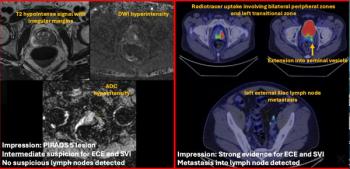An emerging deep learning (DL) model, which assesses magnetic resonance imaging (MRI) and clinical data, demonstrated a nine percent higher C-index for predicting prostate cancer (PCa) progression than two established risk calculators drawn from the European Randomized Study of Screening for Prostate Cancer (ERSPC) and the Prostate Cancer Prevention Trial (PCPT).
For the multicenter retrospective study, recently published in Radiology: Imaging Cancer, the researchers assessed the DL model in 1,143 patients (median age of 64) and 1,607 MRI scans. In addition to evaluation of baseline MRI exams, the DL model reviewed clinical parameters including patient age, prostate-specific antigen (PSA) level, PSA density and prostate volume, according to the study. The internal test set was comprised of 686 patients and a total of 829 MRI scan, and external validation testing was conducted in 457 patients (778 MRI scans).
The researchers found that internal testing showed a higher C-index for the DL model (68 percent) in contrast to 59 percent for the ERPC and PCPT risk calculator models for predicting the progression of low-risk PCa to clinically significant prostate cancer (csPCa). The study authors noted no significant differences between the tools with respect to the C-index in external validation testing with the DL model being equivalent to the PCP risk calculator (56 percent) and lower than the ERSPC risk calculator model (61 percent).
However, the researchers also determined in external validation testing that the DL model was associated with a hazard ratio (HR) of 1.32 for predicting progression to csPCa in comparison to 1.24 for the ERSPC (1.24) and PCPT models (1.09).
Employing the DL scoring model, the study authors said external validation testing showed that not having follow-up imaging for two years in the DL risk group < 1 had less than 10 percent risk of missing csPCa development. The absence of follow-up imaging for three years in this patient population was associated with a 13 percent risk of having csPCa, according to the researchers.
“In our analysis, follow-up schedules based on DL risk scores would have allowed a substantial proportion of patients to forego follow-up for 3 years with 13% or lower risk of missing disease progression,” wrote lead study author Christian Roest, MSc, who is affiliated with the Department of Radiology at University Medical Center Groningen in Groningen, the Netherlands, and colleagues.
(Editor’s note: For addition content on prostate cancer imaging, click here.)
Three Key Takeaways
- Superior predictive performance? While the deep learning (DL) model demonstrated a 9 percent higher C-index for predicting prostate cancer progression (68 prercent) in comparison to established risk calculators, such as the ERSPC and PCPT models (59 percent) in internal testing, external validation testing did not show a significant difference with respect to the C-index.
- Extended follow-up intervals. The DL model's scoring system may support extending follow-up imaging intervals for low-risk patients, allowing some to forego follow-up for up to three years with a low risk (< 13 percent) of missing clinically significant prostate cancer (csPCa) progression.
- Versatility across surveillance protocols: The DL model provided a hazard ratio of 1.44 for predicting progression to more aggressive PCa (ISUP grade ≥3), underscoring its potential utility in diverse active surveillance protocols and personalized risk assessments.
When assessing the DL risk scoring model to predict PCa progression to International Society of Urological Pathology (ISUP) grades of > 3, the researchers noted the DL model had a 1.44 HR.
“This result is particularly relevant because some active surveillance protocols may allow patients who have PCa with an ISUP grade of 2 to enroll under specific conditions (eg, the absence of cribriform growth or use less strict criteria (eg, ISUP grade ≥ 3) to trigger active treatment,” added Roest and colleagues. “ … The model’s ability to estimate the risk of progression to PCa with ISUP grade 3 or higher suggests the utility of DL risk scores across diverse surveillance protocols.”
(Editor’s note: For related content, see “Study Emphasizes PSMA PET Staging of High-Risk, Hormone-Sensitive Prostate Cancer,” “AI Segmentation, Intraprostatic Tumor Volume and Metastases: What a New mpMRI Study Reveals” and “MRI-Based AI Radiomics Model Offers ‘Robust’ Prediction of Perineural Invasion in Prostate Cancer.”)
In regard to study limitations, the authors acknowledged differences between the two institutions contributing to the cohort of reviewed cases with one facility opting to conduct prostate biopsies prior to initial MRI. They also conceded that the intended population for the PCPT risk indicator differed from that of the study cohort for the MRI-based deep learning tool for estimating risk for PCa progression.





























